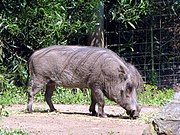| Warthog | |
|---|---|

| |
| Male common warthog Phacochoerus africanus Tswalu Kalahari Reserve, South Africa | |
| Scientific classification | |
| Domain: | Eukaryota |
| Kingdom: | Animalia |
| Phylum: | Chordata |
| Class: | Mammalia |
| Order: | Artiodactyla |
| Family: | Suidae |
| Tribe: | Phacochoerini |
| Genus: | Phacochoerus F. Cuvier, 1826 |
| Type species | |
| Aper aethiopicus Pallas, 1766 | |
| Species | |
| Synonyms | |
| |
Phacochoerus is a genus in the family Suidae, commonly known as warthogs (pronounced wart-hog). They are pigs who live in open and semi-open habitats, even in quite arid regions, in sub-Saharan Africa. The two species were formerly considered conspecific under the scientific name Phacochoerus aethiopicus, but today this is limited to the desert warthog, while the best-known and most widespread species, the common warthog (or simply warthog), is Phacochoerus africanus.

Description
Although covered in bristly hairs, a warthog's body and head appear largely bare, from a distance, with only a crest of hair along the back and the tufts on the face and tail being obvious. The English name "wart"-hog refers to their facial wattles, which are particularly distinct in males. The males also have very prominent tusks, which reach a length of 10 to 25 inches (25 to 64 centimetres); females' tusks are always smaller. They are largely herbivorous, but, like most suids, opportunistically eat invertebrates or small animals, even scavenging on carrion. While both species remain fairly common and widespread, and considered to be of Least Concern by the IUCN, the nominate subspecies of desert warthog, commonly known as the Cape warthog (P. a. aethiopicus) was extinct by around 1865.
Species in taxonomic order
The genus Phacochoerus contains two species. The two species emerged from ecological barriers. P. africanus were found with a lack of upper incisors, while P. aethiopicus were found with a full set.
| Common name | Scientific name and subspecies | Range | Size and ecology | IUCN status and estimated population |
|---|---|---|---|---|
| Common warthog | Phacochoerus africanus (Gmelin, 1788) Four subspecies
|
Widespread in the savannah of Sub-Saharan Africa from Senegal to Ethiopia down to South Africa, absent from heavily forested or desert areas.
|
Size: A head-and-body length ranging from 0.9 to 1.5 m (2 ft 11 in to 4 ft 11 in), and shoulder height from 63.5 to 85 cm (25.0 to 33.5 in). Females, at 45 to 75 kg (99 to 165 lb), are smaller and lighter than males, at 60 to 150 kg (130 to 330 lb). Habitat: Diet: |
LC
|
| Desert warthog | Phacochoerus aethiopicus (Pallas, 1766) Two subspecies
|
Northern Kenya and Somalia, and possibly Djibouti, Eritrea, and Ethiopia.
|
Size: Average length of 125 centimetres (49 in) and weight of 75 kilograms (165 lb) with males being larger than females. Habitat: Diet: |
LC
|
References
- Wilson, D. E.; Reeder, D. M., eds. (2005). Mammal Species of the World: A Taxonomic and Geographic Reference (3rd ed.). Johns Hopkins University Press. ISBN 978-0-8018-8221-0. OCLC 62265494.
- Wilson, D. E.; Reeder, D. M., eds. (2005). Mammal Species of the World: A Taxonomic and Geographic Reference (3rd ed.). Johns Hopkins University Press. ISBN 978-0-8018-8221-0. OCLC 62265494.
- Novak, R. M. (editor) (1999). Walker's Mammals of the World. Vol. 2. 6th edition. Johns Hopkins University Press, Baltimore. ISBN 0-8018-5789-9.
- Kingdon, J. (1997). The Kingdon Guide to African Mammals. Academic Press Limited, London. ISBN 0-12-408355-2.
- d'Huart, J.P.; Butynski, T.M.M. & De Jong, Y. (2008). "Phacochoerus aethiopicus". IUCN Red List of Threatened Species. 2008. Retrieved 20 April 2010.{{cite iucn}}: old-form url (help)
- ^ d'Huart, JP; Grubb, P (2001). "Distribution of the common warthog (Phacochoerus africanus) and the desert warthog (Phacochoerus aethiopicus) in the Horn of Africa". African Journal of Ecology. 39 (2): 156–169. doi:10.1046/j.0141-6707.2000.00298.x – via Web of Science.
- "Common Warthog Phacochoerus africanus" (PDF). Archived from the original (PDF) on 15 May 2013. Retrieved 2013-07-30.
- d'Huart, J.P.; Butynski, T.M.M. & De Jong, Y. (2016) . "Phacochoerus aethiopicus". IUCN Red List of Threatened Species. 2016: e.T41767A99376685. doi:10.2305/IUCN.UK.2016-1.RLTS.T41767A44140316.en. Retrieved 12 April 2022. Database entry includes a brief justification of why this species is of least concern.
- Winkelstern, Ian (2009). "Phacochoerus aethiopicus". Animal Diversity Web. University of Michigan. Retrieved 2013-09-04.
External links
- [REDACTED] Media related to Phacochoerus at Wikimedia Commons
- [REDACTED] Data related to Phacochoerus at Wikispecies
- d'Huart, J.P. & Grubb, P. (2005). A photographic guide to the differences between the Common Warthog (Phacochoerus africanus) and the Desert Warthog (Ph. aethiopicus). Suiform Soundings 5(2): 4–8.
| Genera of peccaries, pigs and their extinct allies | |||||||||||||||||||||||||||||||||||
|---|---|---|---|---|---|---|---|---|---|---|---|---|---|---|---|---|---|---|---|---|---|---|---|---|---|---|---|---|---|---|---|---|---|---|---|
| |||||||||||||||||||||||||||||||||||
| |||||||||||||||||||||||||||||||||||
| |||||||||||||||||||||||||||||||||||
| Taxon identifiers | |
|---|---|
| Phacochoerus | |

